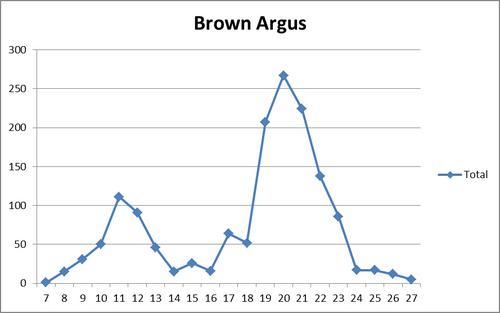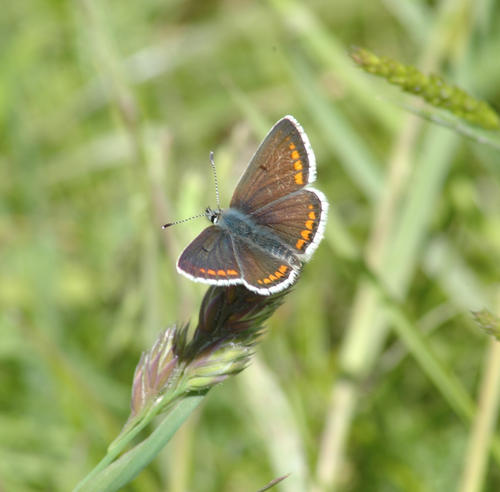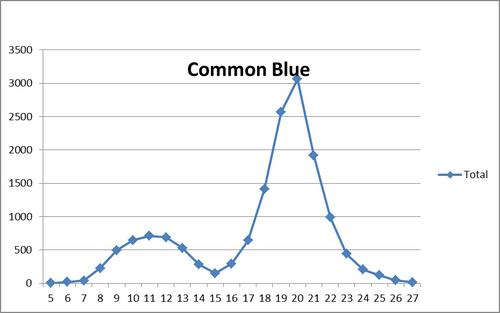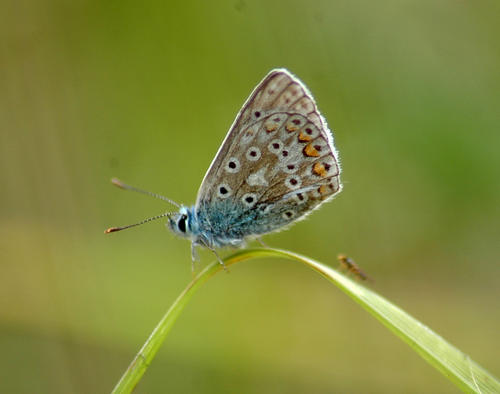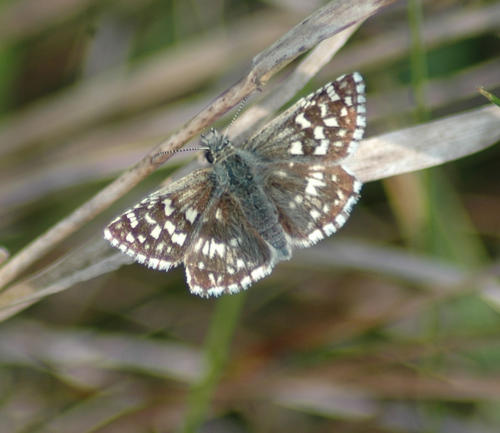Worcestershire butterfly transects
John Tilt
The Butterfly Transect is our way of measuring butterfly populations either on a site basis or within an area. The Transect involves walking a predetermined route within the site over a period of 26 weeks each year. The route can be divided into sections dependant on habitat types (up to 15 different sections can be used). When the route is walked the recorder counts all the butterflies seen within a 5m or 10m distance, taking care not to count a butterfly twice. The Species - Number and Section are recorded. The weather on each visit is also recorded.
At the end of the walk the counts are entered into free software - Transect Walker 2.5 and at the end of the season the data are packaged and sent to the UK Butterfly Recording Scheme via the Transect Coordinator. The data are analysed and an annual report is compiled showing species trends.
The data from Worcestershire Transects have been extracted and analysed.
Worcestershire has 21 transects. These tend to be on nature reserves and on areas where some of the rarer butterflies are found. So these results do not reflect what is happening in the wider countryside. There is a separate recording scheme for doing this.
In 2010, 32000 butterflies were recorded 63 people and over 1000 man-hours were involved.
The Analysis.
First, the transect results are adjusted for missed weeks (holidays or bad weather etc). Where transects are walked on consecutive years trends can be calculated by pairing the counts from consecutive years.
Table 1 shows the trends for Worcestershire over the last 5 years for the commoner butterflies. Starting at 2006 showing +/-% for 2007 to 2010.
The figures show that in 2007, 26 of the 33 commoner species were declining compared with 2006. Nationally 2007 was the second lowest year in the 31 years since the scheme was started. This was put down largely to weather conditions - cold wet spring etc.
2008 and 2009 showed a considerable recovery of most species and 2010 consolidated that recovery.
Looking at individual species.
Brown Argus shows a considerable increase, particularly in 2010. The species is double brooded and has a fairly small first brood, when the second brood emerges the adults scatter widely into all sorts of habitats a number of sites only have a second brood.
Exactly the same pattern is shown for Common Blue with very high numbers in 2010, particularly for the second brood.
The migration explosion of Painted Lady is clearly shown in 2009
Small Tortoiseshells are showing a recovery after a few poor years due to the well documented parasite Sturmia bella.
Table 2 shows the butterfly numbers on 12 of Worcestershire sites which have been walked consistently over the last 5 years. After adjusting for missed weeks this enables us to calculate and index for the commoner butterflies. 2006 is shown as an index of 100 and the succeeding year calculated in relation to this.
Showing clearly the decline in 2007 (index of 82) in recovering to 121 in 2010.
This shows again significant increases for Brown Argus and common Blue.
The steadily improving species are highlighted in blue and species not doing so well are highlighted in red.
By far our commonest butterfly on our 12 sites was Meadow Brown but in 2010 only Ringlet showed to be more common.
Regional Action Span Species
Grizzled Skipper – Still present on Honebourne Railway line, Throckmorton Landfill site, Hipton Hill, Wyre Forest.
Dingy Skipper – Two Sites on the west side of the Malverns – Pennyhill Bank.
Pearl-bordered Fritillary – Doing quite well in Wyre and will be introduced to Grafton Wood this spring.
Small Pearl-bordered – Improved counts in Wyre
White Admiral – Showing a decline on the 12 sites and also a nationally.
Silver-washed Fritillary – Showing improvements in Worcestershire (Best year ever in Grafton Wood)
Dark Green Fritillary – Only very small numbers on west side of Malvern Hill.
High Brown Fritillary – Now lost to Worcestershire none seen on Malvern in 2010.
Wood White – Lost now in Worcestershire but small numbers found in Wyre and doing well over the border in Hereford but nationally a significant decline.
White Letter Hairstreak – Small colonies are being found around the county, for example in Trench Wood and at Brotheridge Green reserve.
Brown Hairstreak – Numbers stable – a good egg-count in 2010.
Grayling – Small colony is stable around North Hill Malvern
If any of the above species are recorded in Worcestershire please send the records to myself at john.tilt2@btopenworld.com.
| Paired Counts 2006 -2010 | ||||
| . | % increase/Decrease | |||
| Species | 2007 | 2008 | 2009 | 2010 |
| Brimstone | -2 | -37 | 94 | 13 |
| Brown Argus | -88 | 138 | 49 | 516 |
| Brown Hairstreak | -83 | 60 | 108 | 7 |
| Comma | -45 | -9 | 249 | -21 |
| Common Blue | -87 | 114 | 111 | 463 |
| Dark Green Fritillary | -74 | 296 | -36 | -94 |
| Essex Skipper | -31 | 261 | 51 | -37 |
| Gatekeeper | -42 | 85 | 9 | -12 |
| Green Hairstreak | 2 | 122 | -9 | -65 |
| Green-veined White | 81 | 16 | 190 | -20 |
| Holly Blue | 117 | -5 | -58 | 154 |
| Large Skipper | 7 | -28 | 124 | 71 |
| Large White | -2 | 17 | 250 | -56 |
| Marbled White | -30 | -31 | 44 | -29 |
| Meadow Brown | -2 | 62 | -14 | -37 |
| Orange-tip | 26 | -36 | 184 | 20 |
| Painted Lady | -90 | -93 | 90248 | -97 |
| Peacock | 169 | -62 | 78 | 38 |
| Pearl-bordered Fritillary | 765 | -94 | 200 | 33 |
| Purple Hairstreak | -81 | 117 | 27 | 112 |
| Red Admiral | -6 | -48 | 90 | -29 |
| Ringlet | -25 | 32 | 87 | 25 |
| Silver-washed Fritillary | -4 | 21 | 70 | 50 |
| Small Copper | -61 | 16 | 26 | 69 |
| Small Heath | -42 | -31 | 2 | 161 |
| Small Pearl-bordered Fritillary | -24 | -85 | 250 | 1129 |
| Small Skipper | -80 | 45 | 290 | -16 |
| Small Tortoiseshell | -30 | -31 | 127 | 120 |
| Small White | -25 | 18 | 207 | -19 |
| Small/Essex Skipper | -12 | 27 | 29 | -48 |
| Speckled Wood | -27 | 69 | 84 | -18 |
| White Admiral | -50 | 3 | 19 | 69 |
| White-letter Hairstreak | -100 | 0 | 850 | |
| Increases | 7 | 19 | 28 | 18 |
| Decreases | 26 | 13 | 4 | 15 |
Table 1. Paired counts 2006-2010.
In Worcestershire we have 12 sites which have been walked for the last five years, this gives us a good indication of population changes over that period. Table 2 shows this. An index has been calculated using 100 for 2006 then the relative index for subsequent years for each species.
The 12 Sites are: Blackminster, Castlemorton Common, Chaddesely Woods Chase End Malvern, Grafton Wood, Knapp and Papermill, Monkwood, St Wulstans Reserve (Malvern), West Malvern, Windmill Hill, Wyre Forest East, Wyre Forest West.
The species highlighted in red show declines and those in blue increases. It must be appreciated that this is a very small sample. However in is clear to see that there has been a recovery after the seriously poor year of 2007.
Good news that the Small Tortoiseshell is recovering after the well documented parasite problems. In general table 2 shows a fairly optimistic situation. A lot the sites in this sample have had some management work for butterflies e.g. The Malverns, Grafton Wood, Monkwood and Knapp and Papermill.
Worcestershire Wildlife Trust has now recognised the importance of monitoring the effects of their management and has set up Transect on 12 of their reserves. The data are fed back to the reserve management to help plan habitat work.
The results of nationwide transects can be viewed on the UK butterfly monitoring site http://www.ukbms.org/ where data from all transects can be viewed together with the annual report.
Anyone interested in helping with a transect should contact John Tilt at john.tilt2@btopenworld.com.
-
Table 2 Sum of Value Index 2006=100
2006
2007
2008
2009
2010
2006
2007
2008
2009
2010
Brimstone 465
443
278
412
491
100
95
60
89
106
Brown Argus 40
5
11
14
78
100
12
28
34
194
Brown Hairstreak 10
2
3
5
6
100
17
27
56
59
Clouded Yellow 20
100
0
0
0
0
Comma 372
193
170
422
348
100
52
46
113
94
Common Blue 533
71
145
276
1309
100
13
27
52
246
Dark Green Fritillary 26
7
18
14
100
26
70
53
0
Dingy Skipper 1
7
3
100
700
0
0
300
Essex Skipper 13
9
33
36
29
100
69
250
277
221
Gatekeeper 2089
1153
1836
1778
1636
100
55
88
85
78
Grayling 1
1
100
0
0
0
100
Green Hairstreak 10
10
13
20
7
100
102
129
205
72
Green-veined White 559
887
990
2565
1918
100
159
177
459
343
Holly Blue 35
58
48
24
33
100
167
138
69
94
Large Skipper 190
202
136
228
436
100
106
72
120
229
Large White 452
417
477
1228
425
100
92
106
272
94
Marbled White 716
472
305
299
247
100
66
43
42
35
Meadow Brown 3908
3567
5505
3967
2537
100
91
141
102
65
Orange-tip 209
251
159
420
491
100
120
76
201
235
Painted Lady 138
14
1
705
19
100
10
1
511
14
Peacock 463
1237
466
583
941
100
267
101
126
203
Pearl-bordered Fritillary 31
268
17
51
68
100
865
55
164
218
Purple Hairstreak 27
5
11
12
19
100
19
41
45
70
Red Admiral 165
146
78
82
59
100
88
47
50
36
Ringlet 2333
1647
2133
2961
4180
100
71
91
127
179
Silver-washed Fritillary 201
193
234
381
530
100
96
116
189
264
2006
2007
2008
2009
2010
2006
2007
2008
2009
2010
Small Copper 225
86
86
94
187
100
38
38
42
83
Small Heath 84
49
18
30
89
100
58
22
36
106
Small Pearl-bordered Fritillary
17
13
2
7
86
100
76
12
41
506
Small Skipper 237
48
68
214
225
100
20
29
90
95
Small Tortoiseshell 64
44
29
51
134
100
68
45
79
208
Small White 597
440
502
829
926
100
74
84
139
155
Small/Essex Skipper 316
278
315
433
199
100
88
100
137
63
Speckled Wood 1010
620
1025
1521
1299
100
61
101
151
129
White Admiral 207
104
107
109
166
100
50
52
52
80
White-letter Hairstreak 3
2
1
17
100
0
67
33
567
Wood White 16
4
5
1
100
23
34
0
6
Grand Total 15783
12948
15227
19770
19140
100
82
96
125
121
Images
Fig. 1. Weekly transect counts 2010 Brown Argus. ©John Tilt.
Fig. 2. Brown Argus. ©John Tilt
Fig. 3. Weekly transect counts 2010 Common Blue. ©John Tilt.
Fig. 4. Common Blue ©John Tilt
Fig.5. Grizzled Skipper ©John Tilt
